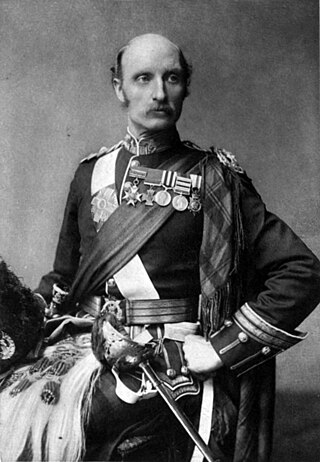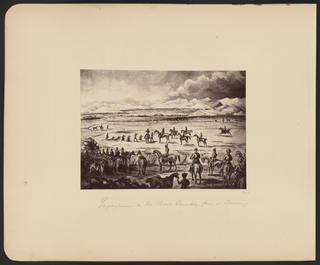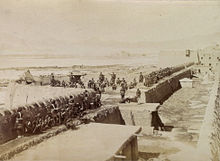
European influence in Afghanistan has been present in the country since the Victorian era, when the competing imperial powers of Britain and Russia contested for control over Afghanistan as part of the Great Game.

The Third Anglo-Afghan War began on 6 May 1919 when the Emirate of Afghanistan invaded British India and ended with an armistice on 8 August 1919. The Anglo-Afghan Treaty of 1919 resulted in the Afghans gaining control of foreign affairs from Britain and the British recognizing the Durand Line as the border between Afghanistan and British India.

The Second Anglo-Afghan War was a military conflict fought between the British Raj and the Emirate of Afghanistan from 1878 to 1880, when the latter was ruled by Sher Ali Khan of the Barakzai dynasty, the son of former Emir Dost Mohammad Khan. The war was part of the Great Game between the British and Russian empires.

Field Marshal Frederick Sleigh Roberts, 1st Earl Roberts, was a British Victorian era general who became one of the most successful British military commanders of his time. Born in India to an Anglo-Irish family, Roberts joined the East India Company Army and served as a young officer in the Indian Rebellion during which he was awarded the Victoria Cross for gallantry. He was then transferred to the British Army and fought in the Expedition to Abyssinia and the Second Anglo-Afghan War, in which his exploits earned him widespread fame. Roberts would go on to serve as the Commander-in-Chief, India before leading British Forces for a year during the Second Boer War. He also became the last Commander-in-Chief of the Forces before the post was abolished in 1904.

Field Marshal Sir George Stuart White, was an officer of the British Army. He was stationed at Peshawar during the Indian Mutiny and then fought at the Battle of Charasiab in October 1879 and at the Battle of Kandahar in September 1880 during the Second Anglo-Afghan War. For his bravery during these two battles, he was awarded the Victoria Cross. He went on to command a brigade during the Third Anglo-Burmese War in 1886 and became commander of Quetta District in 1889 in which role he led operations in the Zhob Valley and in Balochistan. He was commander of the forces in Natal at the opening of the Second Boer War and fought at the Battle of Elandslaagte in October 1899. He commanded the garrison at the siege of Ladysmith: although instructed by General Sir Redvers Buller to surrender the garrison he responded "I hold Ladysmith for the Queen" and held out for another four months before being relieved in February 1900. He finished his career as Governor of Gibraltar and then as Governor of the Royal Hospital Chelsea.

The North-West Frontier was a region of the British Indian Empire. It remains the western frontier of present-day Pakistan, extending from the Pamir Knot in the north to the Koh-i-Malik Siah in the west, and separating the modern Pakistani frontier regions of North-West Frontier Province, Federally Administered Tribal Areas and Balochistan from neighbouring Afghanistan in the west. The borderline between is officially known as the Durand Line and divides Pashtun inhabitants of these provinces from Pashtuns in eastern Afghanistan.

The Treaty of Gandamak officially ended the first phase of the Second Anglo-Afghan War. The Afghan emir Mohammad Yaqub Khan ceded various frontier areas as well as Afghanistan's control of its foreign affairs to the British Raj.

Field Marshal Sir Donald Martin Stewart, 1st Baronet, was a senior Indian Army officer. He fought on the Aka Khel Expedition to the North-West Frontier in 1854, took part in the response to the Indian Rebellion in 1857 and, after serving as commandant of the penal settlement of the Andaman Islands, fought in the Second Anglo-Afghan War as Commander of the Quetta Army. In that role, he advanced through the Bolan Pass to Quetta, and then on to Kandahar in January 1879. In March 1880, he made a difficult march from Kandahar to Kabul, fighting on the way the Battle of Ahmed Khel and Battle of Arzu, and then holding supreme military and civil command in northern Afghanistan. He became Commander-in-Chief, India in April 1881 and a member of the Council of the Secretary of State for India in 1893.

The Battle of Ahmed Khel took place during the Second Anglo-Afghan War. It was fought on 19 April 1880, on the road between Kandahar and Kabul in central Afghanistan between Afghan tribesmen and soldiers of the British Empire, including forces from both British and Indian armies.

The Kabul Expedition was a punitive campaign undertaken by the British against the Afghans following the disastrous retreat from Kabul. Two British and East India Company armies forced through the Khyber Pass and advanced on the Afghan capital from Kandahar and Jalalabad to avenge the complete annihilation of the British-Indian military-civilian column in January 1842.

The siege of the Sherpur Cantonment was a battle fought in December 1879, during the Second Anglo-Afghan War.

Field Marshal Sir Arthur Arnold Barrett, was a British officer of the Indian Army. He saw action at the Siege of the Sherpur Cantonment in December 1879 and at the Battle of Kandahar in September 1880 during the Second Anglo-Afghan War and went on to serve in the Hunza-Nagar Campaign in 1891. During the First World War he was General Officer Commanding the Poona Division which successfully took Basra in Mesopotamia in November 1914 and then Al-Qurnah in Mesopotamia in December 1914. He spent the rest of the War commanding the Northern Army in which role he took part in operations against the Mahsuds in Spring 1917. He saw action again as the senior British officer on the ground during the Third Anglo-Afghan War in 1919 before retiring in May 1920.

The Afghanistan Medal, sanctioned on 19 March 1881, was awarded to members of the British and Indian armies who served in Afghanistan between 1878 and 1880 during the Second Afghan War, the first war being from 1839 to 1842.
The Peshawar Valley Field Force was a British field force. It was the largest of three military columns created in November 1878 at the start of the Second Anglo-Afghan War (1878–1880), each of which invaded Afghanistan by a different route. The Peshawar force initially consisted of around 16,000 men, a mix of both British and Indian Army regiments, under the command of Lieutenant General Sir Samuel J. Browne.

The Kabul to Kandahar Star, also known as the Roberts Star or Kandahar Bronze Star was awarded to those British and Indian troops who participated in the 320 mile march from Kabul to Kandahar in Afghanistan between 9–31 August 1880, under the command of Lieutenant-General Sir Frederick Roberts who rode horseback on his horse Vonolel In addition, it was awarded to the troops stationed en route at Kelat-i-Ghilzie, who accompanied General Roberts on the final ninety miles to Kandahar.

The Battle of Charasiab was fought on 6 October 1879 during the Second Anglo-Afghan War between British and Indian troops against Afghan regular forces and tribesmen.
General Sir Alexander Robert Badcock, was a general in the British Indian Army.

The Kurram Valley Field Force was a British military formation during the first phase of the Second Afghan War, 1878–79.
Sir Æneas Perkins, KCB was a Bengal Army and British Army officer.
















